The Approach: a dialogue mapping story
Jack could see that the discussion was going nowhere: the group been talking about the pros and cons of competing approaches for over half an hour, but they kept going around in circles. As he mulled over this, Jack got an idea – he’d been playing around with a visual notation called IBIS (Issue-Based Information System) for a while, and was looking for an opportunity to use it to map out a discussion in real time (Editor’s note: readers unfamiliar with IBIS may want to have a look at this post and this one before proceeding). “Why not give it a try,” he thought, “I can’t do any worse than this lot.” Decision made, he waited for a break in the conversation and dived in when he got one…
“I have a suggestion,” he said. “There’s this conversation mapping tool that I’ve been exploring for a while. I believe it might help us reach a common understanding of the approaches we’ve been discussing. It may even help facilitate a decision. Do you mind if I try it?”
“Pfft – I’m all for it if it helps us get to a decision.” said Max. He’d clearly had enough too.
Jack looked around the table. Mary looked puzzled, but nodded her assent. Rick seemed unenthusiastic, but didn’t voice any objections. Andrew – the boss – had a here-he-goes-again look on his face (Jack had a track record of “ideas”) but, to Jack’s surprise, said, “OK. Why not? Go for it.”
“Give me a minute to get set up,” said Jack. He hooked his computer to the data projector. Within a couple of minutes, he had a blank IBIS map displayed on-screen. This done, he glanced up at the others: they were looking at screen with expressions ranging from curiosity (Mary) to skepticism (Max).
“Just a few words about what I’m going to do, he said. “I’ll be using a notation called IBIS – or issue based information system – to capture our discussion. IBIS has three elements: issues, ideas and arguments. I’ll explain these as we go along. OK – Let’s get started with figuring out what we want out of the discussion. What’s our aim?” he asked.
His starting spiel done, Jack glanced at his colleagues: Max seemed a tad more skeptical than before; Rick ever more bored; Andrew and Mary stared at the screen. No one said anything.
Just as he was about to prompt them by asking another question, Mary said, “I’d say it’s to explore options for implementing the new system and find the most suitable one. Phrased as a question: How do we implement system X?”
Jack glanced at the others. They all seemed to agree – or at least, didn’t disagree – with Mary, “Excellent,” he said, “I think that’s a very good summary of what we’re trying to do.” He drew a question node on the map and continued: “Most discussions of this kind are aimed at resolving issues or questions. Our root question is: What are our options for implementing system X, or as Mary put it, How do we implement System X.”
“So, what’s next,” asked Max. He still looked skeptical, but Jack could see that he was intrigued. Not bad, he thought to himself….
“Well, the next step is to explore ideas that address or resolve the issue. So, ideas should be responses to the question: how should we implement system X? Any suggestions?”
“We’d have to engage consultants,” said Max. “We don’t have in-house skills to implement it ourselves.”
Jack created an idea node on the map and began typing. “OK – so we hire consultants,” he said. He looked up at the others and continued, “In IBIS, ideas are depicted by light bulbs. Since ideas respond to questions, I draw an arrow from the idea to the root question, like so:
“I think doing it ourselves is an option,” said Mary, “We’d need training and it might take us longer because we’d be learning on the job, but it is a viable option. ”
“Good,” said Jack, “You’ve given us another option and some ways in which we might go about implementing the option. Ideally, each node should represent a single – or atomic – point. So I’ll capture what you’ve said like so.” He typed as fast he could, drawing nodes and filling in detail.
As he wrote he said, “Mary said we could do it ourselves – that’s clearly a new idea – an implementation option. She also partly described how we might go about it: through training to learn the technology and by learning on the job. I’ve added in “How” as a question and the two points that describe how we’d do it as ideas responding to the question.” He paused and looked around to check that every one was with him, then continued. “But there’s more: she also mentioned a shortcoming of doing it ourselves – it will take longer. I capture this as an argument against the idea; a con, depicted as red minus in the map.”
He paused briefly to look at his handiwork on-screen, then asked, “Any questions?”
Rick asked, “Are there any rules governing how nodes are connected?”
“Good question! In a nutshell: ideas respond to questions and arguments respond to ideas. Issues, on the other hand, can be generated from any type of node. I can give you some links to references on the Web if you’re interested.”
“That might be useful for everyone,” said Andrew. “Send it out to all of us.”
“Sure. Let’s move on. So, does anyone have any other options?”
“Umm..not sure how it would work, but what about co-development?” Suggested Rick.
“Do you mean collaborative development with external resources?” asked Jack as he began typing.
“Yes,” confirmed Rick.
“What about costs? We have a limited budget for this,” said Mary.
“Good point,” said Jack as he started typing. “This is a constraint that must be satisfied by all potential approaches.” He stopped typing and looked up at the others, “This is important: criteria apply to all potential approaches, so the criterial question should hang off the root node,” he said. “Does this make sense to everyone?”
“I’m not sure I understand,” said Andrew. “Why are the criteria separate from the approaches?”
“They aren’t separate. They’re a level higher than any specific approach because they apply to all solutions. Put another way, they relate to the root issue – How do we implement system X – rather than a specific solution.”
“Ah, that makes sense,” said Andrew. “This notation seems pretty powerful.”
“It is, and I’ll be happy to show you some more features later, but let’s continue the discussion for now. Are there any other criteria?”
“Well, we must have all the priority 1 features described in the scoping document implemented by the end of the year,” said Andrew. One can always count on the manager to emphasise constraints.
“OK, that’s two criteria actually: must implement priority 1 features and must implement by year end,” said Jack, as he added in the new nodes. “No surprises here,” he continued, “we have the three classic project constraints – budget, scope and time.”
The others were now engaged with the map, looking at it, making notes etc. Jack wanted to avoid driving the discussion, so instead of suggesting how to move things forward, he asked, “What should we consider next?”
“I can’t think of any other approaches,” said Mary. Does anyone have suggestions, or should we look at the pros and cons of the listed approaches?”
“I’ve said it before; I’ll say it again: I think doing it ourselves is a dum..,.sorry, not a good idea. It is fraught with too much risk…” started Max.
“No it isn’t,” countered Mary, “on the contrary, hiring externals is more risky because costs can blowout by much more than if we did it ourselves.”
“Good points,” said Jack, as he noted Mary’s point. “Max, do you have any specific risks in mind?”
“Time – it can take much longer,” said Max.
“We’ve already captured that as a con of the do-it-ourselves approach,” said Jack.
“Hmm…that’s true, but I would reword it to state that we have a hard deadline. Perhaps we could say – may not finish in allotted time – or something similar.”
“That’s a very good point,” said Jack, as he changed the node to read: higher risk of not meeting deadline. The map was coming along nicely now, and had the full attention of folks in the room.
“Alright,” he continued, “so are there any other cons? If not, what about pros – arguments in support of approaches?”
“That’s easy, “ said Mary, “doing it ourselves will improve our knowledge of the technology; we’ll be able to support and maintain the system ourselves.”
“Doing it through consultants will enable us to complete the project quicker,” countered Max.
Jack added in the pros and paused, giving the group some time to reflect on the map.
Rick and Mary, who were sitting next to each other, had a whispered side-conversation going; Andrew and Max were writing something down. Jack waited.
“Mary and I have an idea,” said Rick. “We could take an approach that combines the best of both worlds – external consultants and internal resources. Actually, we’ve already got it down as a separate approach – co-development, but we haven’t discussed it yet..” He had the group’s attention now. “Co-development allows us to use consultants’ expertise where we really need it and develop our own skills too. Yes, we’d need to put some thought into how it would work, but I think we could do it.”
“I can’t see how co-development will reduce the time risk – it will take longer than doing it through consultants.” said Max.
“True,” said Mary, “but it is better than doing it ourselves and, more important, it enables us to develop in-house skills that are needed to support and maintain the application. In the long run, this can add up to a huge saving. Just last week I read that maintenance can be anywhere between 60 to 80 percent of total system costs.”
“So you’re saying that it reduces implementation time and results in a smaller exposure to cost blowout?” asked Jack.
“Yes,” said Mary
Jack added in the pros and waited.
“I still don’t see how it reduces time,” said Max.
“It does, when compared to the option of doing it ourselves,” retorted Mary.
“Wait a second guys,” said Jack. “What if I reword the pros to read – Reduced implementation time compared to in-house option and Reduced cost compared to external option.”
He looked at Mary and Max. – both seemed to OK with this, so he typed in the changes.
Jack asked, “So, are there any other issues, ideas or arguments that anyone would like to add?”
“From what’s on the map, it seems that co-development is the best option,” said Andrew. He looked around to see what the others thought: Rick and Mary were nodding; Max still looked doubtful.
Max asked, “how are we going to figure out who does what? It isn’t easy to partition work cleanly when teams have different levels of expertise.”
Jack typed this in as a con.
“Good point,” said Andrew. “There may be ways to address this concern. Do you think it would help if we brought some consultants in on a day-long engagement to workshop a co-development approach with the team? ”
Max nodded, “Yeah, that might work,” he said. “It’s worth a try anyway. I have my reservations, but co-development seems the best of the three approaches.”
“Great,“ said Andrew, “I’ll get some consultants in next week to help us workshop an approach.”
Jack typed in this exchange, as the others started to gather their things. “Anything else to add?” he asked.
Everyone looked up at the map. “No, that’s it, I think,” said Mary.
“Looks good,” said Mike . “Be sure to send us a copy of the map.”
“Sure, I’ll print copies out right away,” said Jack. “Since we’ve developed it together, there shouldn’t be any points of disagreement.”
“That’s true,” said Andrew, “another good reason to use this tool.” Gathering his papers, he asked, “Is there anything else? He looked around the table. “ Alright then, I’ll see you guys later, I’m off to get some lunch before my next meeting.”
Jack looked around the group. Helped along by IBIS and his facilitation, they’d overcome their differences and reached a collective decision. He had thought it wouldn’t work, but it had.
“ Jack, thanks for your help with the discussion. IBIS seems to be a great way to capture discussions. Don’t forget to send us those references,” said Mary, gathering her notes.
“I’ll do that right away,” said Jack, “and I’ll also send you some information about Compendium – the open-source software tool I used to create the map.”
“Great,” said Mary. “I’ve got to run. See you later.”
“See you later,” replied Jack.
————
Further Reading:
1. Jeff Conklin’s book is a must-read for any one interested in dialogue mapping. I’ve reviewed it here.
2. For more on Compendium, see the Compendium Institute site.
3. See Paul Culmsee’s series of articles, The One Best Practice to Rule Them All, for an excellent and very entertaining introduction to issue mapping.
4. See this post and this one for examples of how IBIS can be used to visualise written arguments.
5. See this article for a dialogue mapping story by Jeff Conklin.


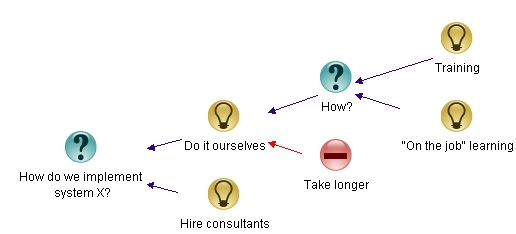


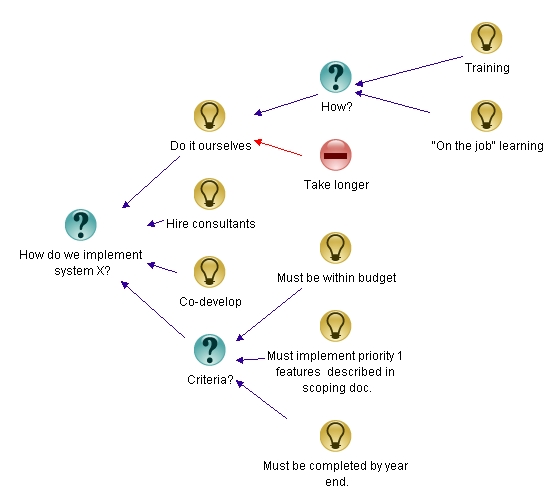

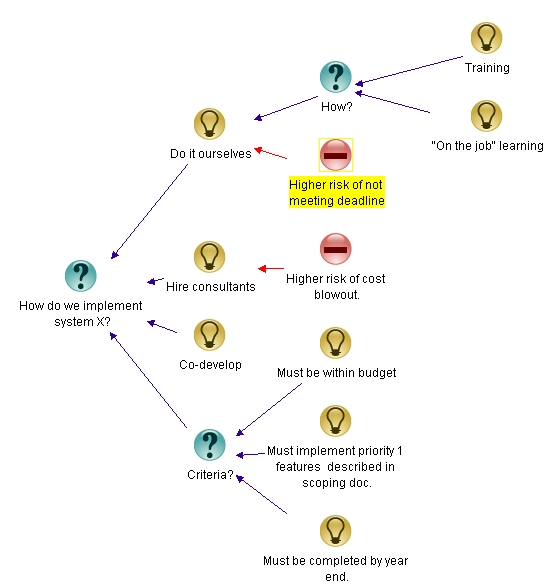
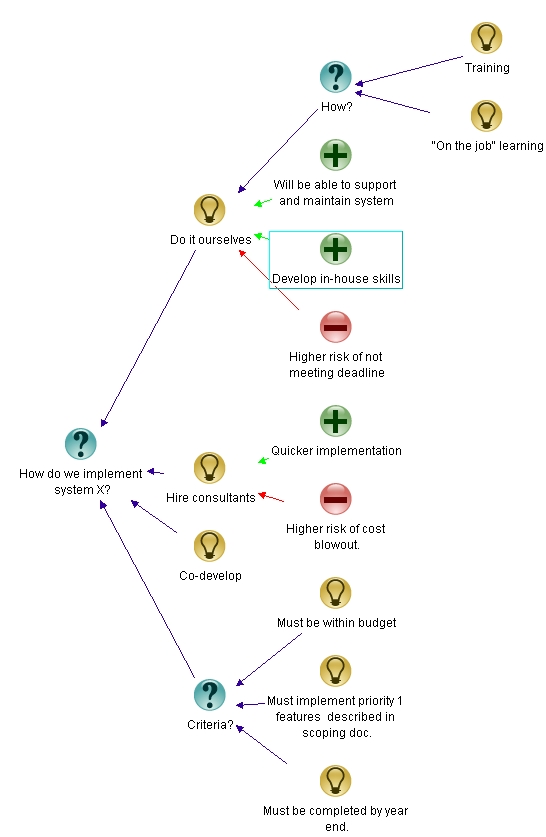
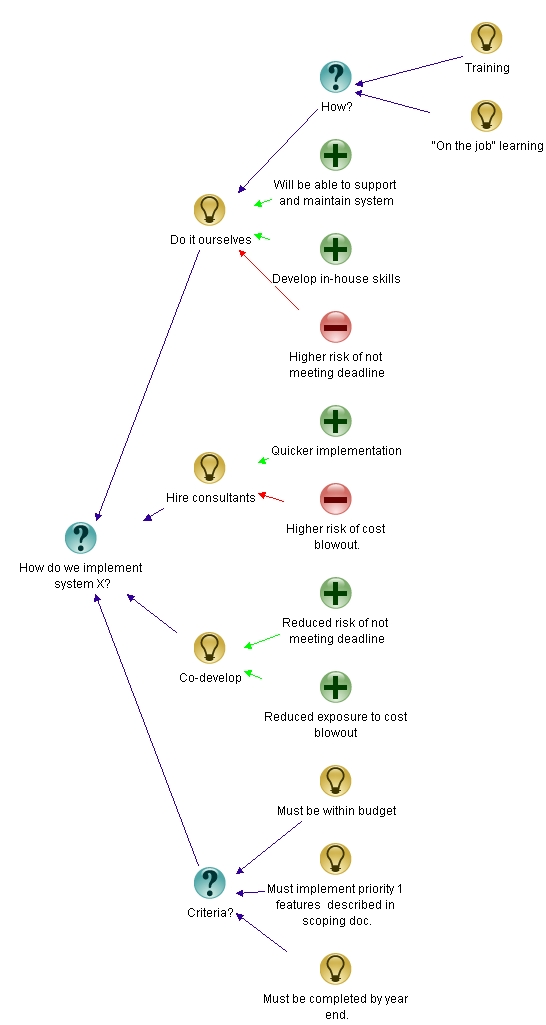

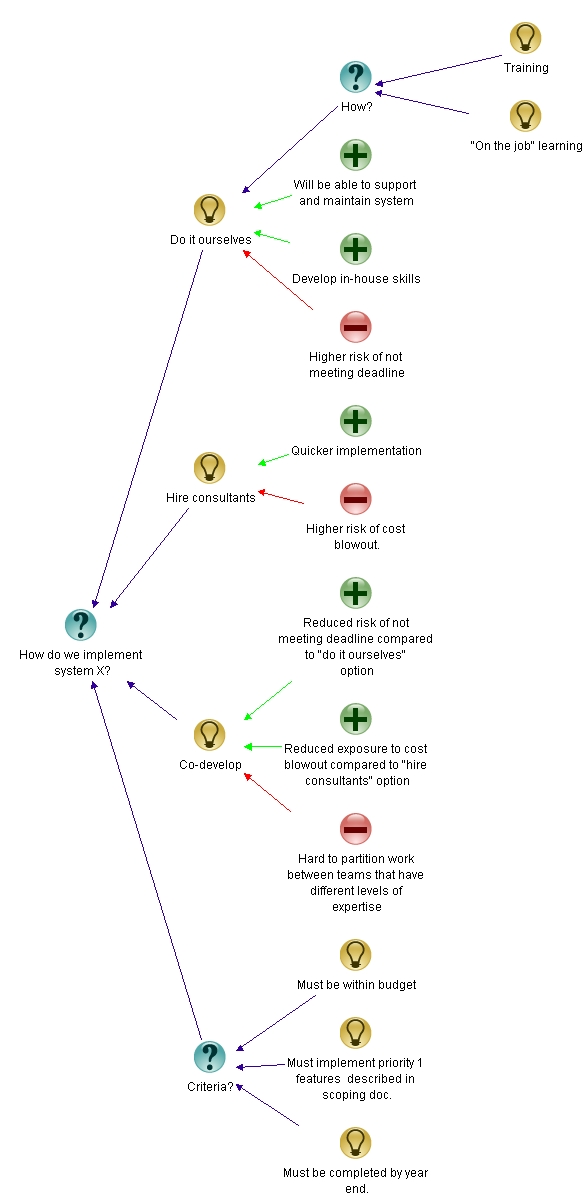
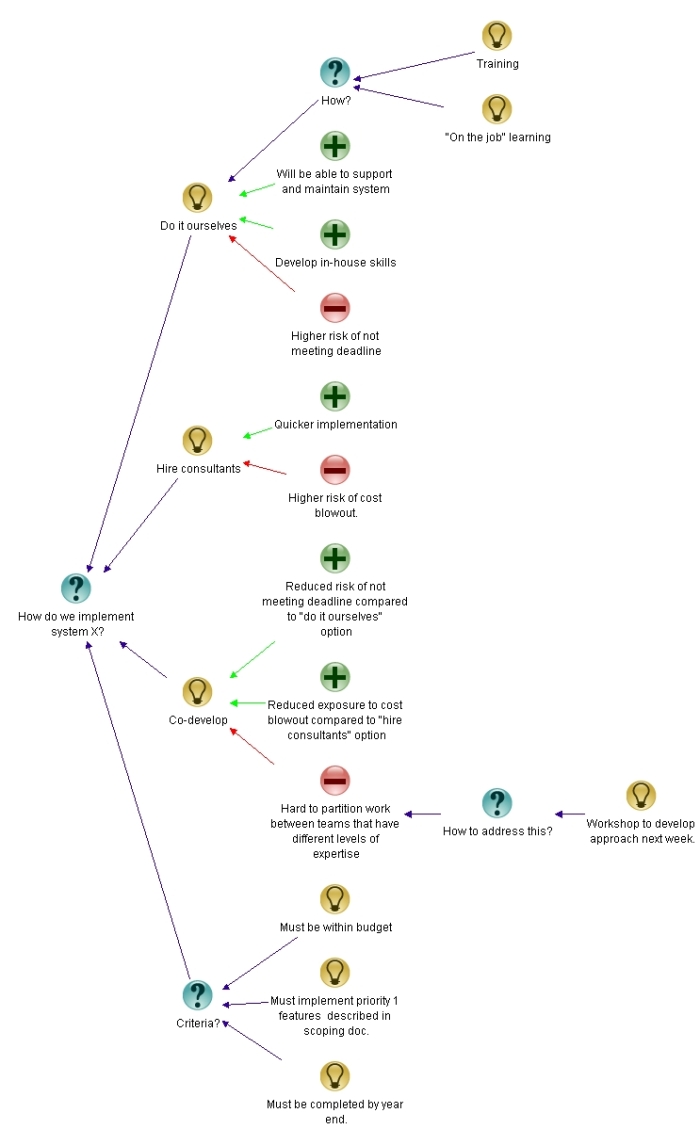


This is a delightful and I think realistic story that may make sense to many people.
Compendium is pretty enough, but I like indented outline form which captures this in less than 25 lines of text with any editor and is trivial to email around or develop further in a wiki. With a shared editor, experienced groups might be able to multi-task to take some strain off the single recording secretary. I’ve never seen that work at all, but I like the idea.
I use Q, A, Pro, and Con as the qualifier/header for each line. For links to other material, I use Ref. For included explanatory stuff, I use Note.
Finally, I would footnote links to Compendium, the book “Dialogue Mapping” By Jeff Conklin, and some blogs and mailing lists.
LikeLike
Richard Karpinski
August 29, 2009 at 11:21 am
Richard,
Thanks for your feedback. You’re right – using Compendium as a collaboration tool requires that everyone involved in the dialogue has it installed (jpeg exports are fine to look at, but that’s about it…). The indented outline form, on the other hand, can be used anywhere, anytime.
Thanks, too, for your suggestion to add in a few references – I’ve done so, and will add to the list as I find more.
Regards,
Kailash.
LikeLike
K
August 29, 2009 at 4:29 pm
Really a terrific narrative of building a useful map. Great contribution!
Al
LikeLike
Al Selvin
August 29, 2009 at 11:03 pm
Thanks, Al.
Regards,
Kailash.
LikeLike
K
August 30, 2009 at 10:13 am
[…] The Approach: a dialogue mapping story « Eight to Late eight2late.wordpress.com/2009/08/27/the-approach-a-dialogue-mapping-story – view page – cached #Eight to Late RSS Feed Eight to Late » The Approach: a dialogue mapping story Comments Feed Eight to Late Keeping meetings on track: “over-time offender” stereotypes An introduction to the critical chain method — From the page […]
LikeLike
Twitter Trackbacks for The Approach: a dialogue mapping story « Eight to Late [eight2late.wordpress.com] on Topsy.com
September 1, 2009 at 9:18 am
Hi Kailash,
What a great story and a fun read (you know you are in to Dialogue Mapping when…)! I have been thoroughly enjoying your posts.
A complementary read is Jeff Conklin’s Dialogue Mapping Experience white paper and book chapter http://cognexus.org/dme/dmepaper.pdf for anyone who is interested!
Have a great one,
Lizzie
LikeLike
Lizzie
September 5, 2009 at 8:36 am
Lizzie,
Thanks for the feedback and the link to Jeff Conklin’s article. I’ve added a link to it in the Further Reading section at the end of my post.
The story was inspired by my experimentation with IBIS and dialogue mapping at work (at a very small scale, I should add!).
Thanks again for your interest in my writing.
Regards,
Kailash.
LikeLike
K
September 5, 2009 at 10:33 am
[…] IBIS: The grammar that is used to create an issue map. When I talk about issues, ideas, pros and cons, I am describing the elements of IBIS grammar. You can read about this elsewhere on my blog, my mentor, Jeff Conklin or the amazing work by Kailash Awati. […]
LikeLike
CleverWorkarounds » The practice of Dialogue Mapping – Part 1
September 10, 2009 at 3:43 pm
[…] a post entitled The Approach: A dialogue mapping story, I presented a fictitious account of the construction of an IBIS map of a project discussion (Note: […]
LikeLike
Capturing decision rationale on projects « Eight to Late
March 10, 2011 at 10:57 pm
Thank you so much for this.
I finally get why I like Compendium, yet never quite understood how to apply it.
LikeLike
Bart Louwagie
April 3, 2011 at 1:45 pm
[…] or this post or this one for examples of IBIS in mapping […]
LikeLike
Improving decision-making in projects (and life) « Eight to Late
June 28, 2012 at 5:12 am
[…] you are no doubt wondering how one can structure and facilitate such discussions. Check out this post for an introduction to one and have a look at my book co-authored with Paul Culmsee for much more. […]
LikeLike
Symptoms, not causes: a systems perspective on project failure | Eight to Late
June 18, 2013 at 9:19 pm
[…] Sensemaking crises are best handled by collaborative problem solving approaches such as Dialogue Mapping. […]
LikeLike
Organisational surprise and its relevance to project management | Eight to Late
November 27, 2013 at 9:38 pm
[…] KA: Yeah that rings true. You know, I was trying to write a blog post once on dialogue mapping, and realized it would be much better to tell it through a story (Editor’s note: …and the result was this post). […]
LikeLike
Making sense of sensemaking – a conversation with Paul Culmsee | Eight to Late
June 18, 2014 at 7:31 am
[…] Figuring out possible states and consequences is largely a matter of scenario envisioning based on knowledge and practical experience. It stands to reason that this is best done by leveraging the collective experience and wisdom of people from diverse backgrounds. This is pretty much the rationale behind collective decision-making techniques such as Dialogue Mapping. […]
LikeLike
Three types of uncertainty that you (probably) overlook | Eight to Late
February 25, 2015 at 9:09 pm
[…] go into details of these here, but if you’re interested, please have a look at my posts entitled, The Approach – a dialogue mapping story and The dilemmas of enterprise IT for brief introductions to the latter two techniques via IT-based […]
LikeLike
TOGAF or not TOGAF… but is that the question? | Eight to Late
March 17, 2015 at 8:10 pm
[…] is an introduction to dialogue mapping via a vignette that illustrates its practice (see this post for another one). I’m publishing it here as I thought it might be useful for those who wish to […]
LikeLike
The Risk – a dialogue mapping vignette | Eight to Late
June 10, 2015 at 9:14 am
[…] The Approach: a dialogue mapping story […]
LikeLike
What is sensemaking? | Eight to Late
March 15, 2016 at 6:03 pm
[…] I’ll send you some books, papers and articles on IBIS (Editor’s note: here are some articles and a couple of […]
LikeLike
The ethical dimension of complex decision making – a metalogue | Eight to Late
October 17, 2022 at 8:24 pm